The Backup Wizard for Exchange Server simplifies the backup operation for Exchange Server databases.
When the Backup Wizard for Exchange Server is used, the Exchange Server database backup settings and operations, both of which require complex procedures, can be simplified by users even without specialist knowledge.
In the Backup Wizard for Exchange Server, the following functions are provided:
Backup Settings and Modification of those Settings using the Wizard
Automatic Generation of Backup Execution Script
Automatic Generation of Backup Settings Deletion Script
The necessary procedures for backup with the Backup Wizard for Exchange Server will be explained.
The flow of the backup task is as follows:
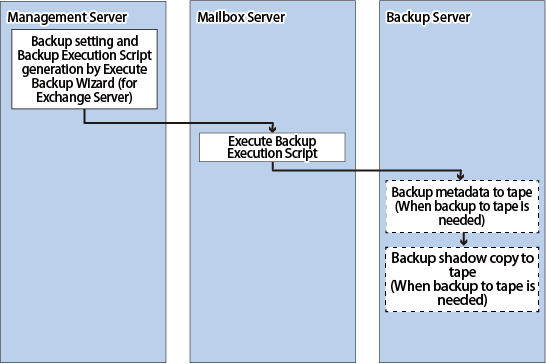
The Restore Wizard for Exchange Server makes restoration operation of the Exchange Server database easy.
When the Restore Wizard for Exchange Server is used, Exchange Server database restoration, which requires complex procedures, can be easily carried out by users even without specialized knowledge.
System Restoration through Restore Execution
The Mailbox Server database can be restored by launching the Restore Wizard, with no need for administrators to restore.
An example for a data center is shown below.
Figure 8.54 Restoration Using Restore Wizard for Exchange Server (Example of Application in Data Center)
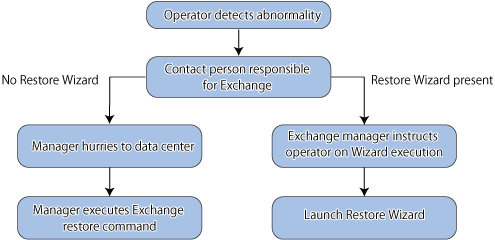
Figure 8.55 Use of Restore Wizard for Exchange Server
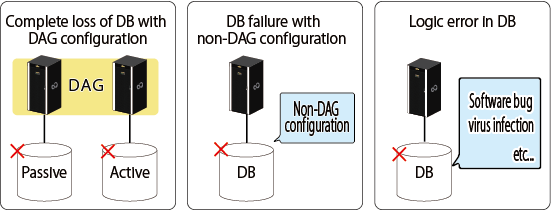
Restore Wizard for Exchange Server can handle the following 3 usage cases.
Complete loss of DB in Database Availability Group (DAG) configuration
DB failure in non-DAG configuration
Logical failure in DB
Information
Figure 8.56 Restoration Using Exchange Server Function
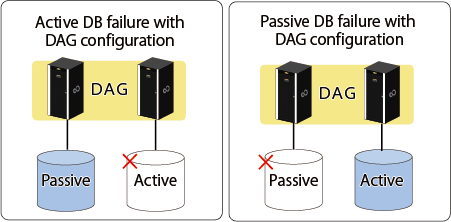
Please use the Exchange Server function for restoration in the following cases.
Active DB failure in DAG configuration
Passive DB failure in DAG configuration
Support Range Provided by Restore Wizard for Exchange Server
The Restore Wizard for Exchange Server is capable of the following restoration.
Restoration Targets
Mailbox database (Active, Passive)
Public folder database
Restoration Point
Roll-forward
Restoring to the point immediately before fault
Point-in-time
Restoring to the point when the (last) backup was taken
Restoration Process
Executing the Restore Wizard for Exchange Server executes the following process in sequence.
Stop QuickOPC session
Activate database (only in case of DAG configuration)
Delete database copy (only in case of DAG configuration)
Permit database overwrite
High-speed restoration of data using the Advanced Copy function of ETERNUS Disk storage system
Mount database
The configuration of the Backup Wizard for Exchange Server and the Restore Wizard for Exchange Server is shown below.
Figure 8.57 System Configuration of Backup Wizard for Exchange Server and Restore Wizard for Exchange Server
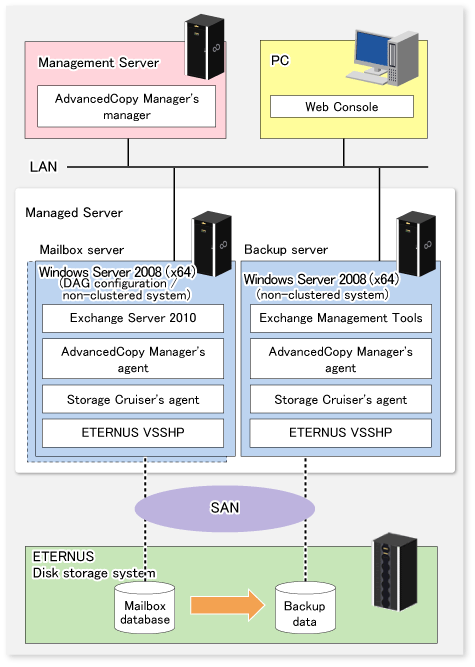
The Management Server manages the Managed Servers (Mailbox Server and backup server). Only one Management Server is installed in the system.
Install the AdvancedCopy Manager's manager on this server.
The Mailbox Server is the server which the ETERNUS Disk storage system on which the mailbox database is stored is connected to.
It is the backup source server for backup operations using the Backup Wizard for Exchange Server.
Install the AdvancedCopy Manager's agent, Storage Cruiser's agent, and ETERNUS VSS Hardware Provider on this server.
Information
The Database Availability Group (DAG) can be configured on two Mailbox Servers.
The backup server is the server which the mailbox database backup destination ETERNUS Disk storage system is connected to.
It is the backup destination server for backup operations using the Backup Wizard for Exchange Server.
Install the AdvancedCopy Manager's agent, Storage Cruiser's agent, and ETERNUS VSS Hardware Provider on this server.
Refer to "8.2.2.1 Designing Server Configurations" about supported server configurations.
The server configuration conditions different from "8.2.2.1 Designing Server Configurations" are shown below:
Only the Management Server can be used in cluster configurations. Other server cluster configurations are not supported.
DAG configurations of four or less Mailbox Servers are supported. DAG configurations of five or more Mailbox Servers are not supported.
Information
With the Backup Wizard, it is possible to use the Mailbox Server as the operation server. In other words, the script generated by the Backup Wizard will be executed where this is created (on the Mailbox Server).
This function supports the following configurations.
DAG Configuration (Management Server: Cluster Configuration)
DAG Configuration (Management Server: Non-cluster Configuration)
Note
Do not operate the backup server in cluster operation mode.
Do not use multiple backup servers for 1 Mailbox Server.
Prepare the dedicated servers respectively for Management Server, the backup server, and Mailbox Server. (Do not combine all 3 applications on one server. Each application will need a dedicated server.)
Make sure that the Exchange Server version and service pack on the backup server and Mailbox Server are equivalent.
The AdvancedCopy Manager's agent (Mailbox Server) platform must be Windows.
Do not allow multiple versions of the Exchange Server to co-exist on 1 backup server or Mailbox Server.
Restore it after it backs up again when the size and the composition of the device that executes the backup of the Exchange Server database are changed.
DAG Configuration (Management Server: Cluster Configuration)
Environment built with the Management Server in cluster configuration with DAG configuration.
Figure 8.58 DAG Configuration (Management Server: Cluster Configuration)
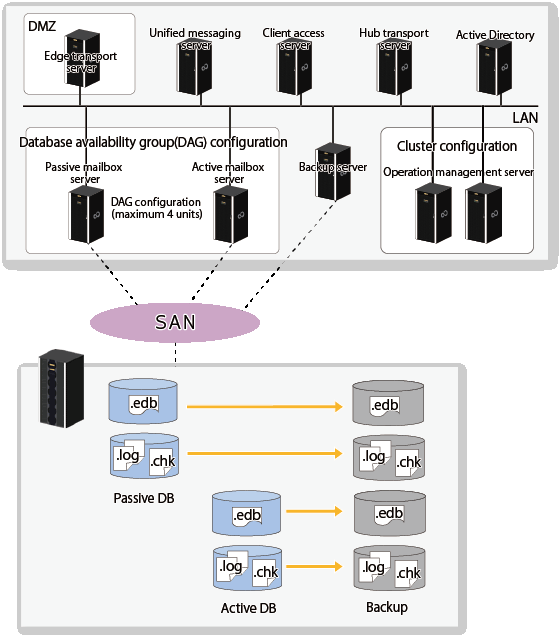
DAG Configuration (Management Server: Non-cluster Configuration)
Environment built with the Management Server in non-cluster configuration with DAG configuration.
Figure 8.59 DAG Configuration (Management Server: Non-cluster Configuration)
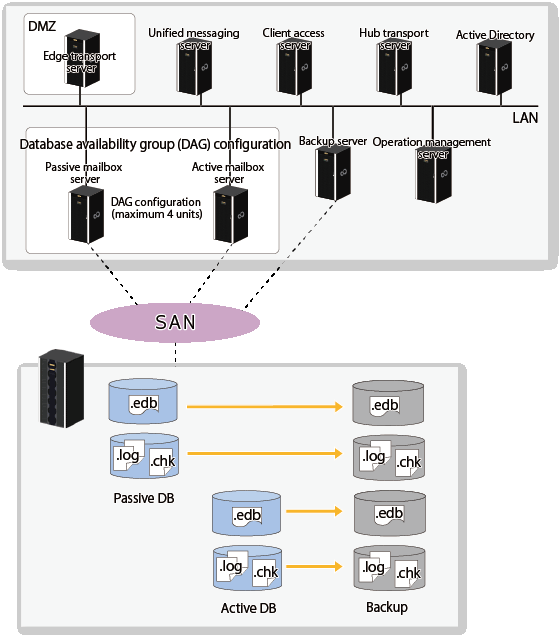
DAG Configuration (Minimum Configuration)
Environment built with the client access server and hub transport server as the same server with DAG configuration.
Figure 8.60 DAG Configuration (Minimum Configuration)

Non-DAG Configuration
Environment that does not have DAG configuration
Figure 8.61 Non-DAG Configuration
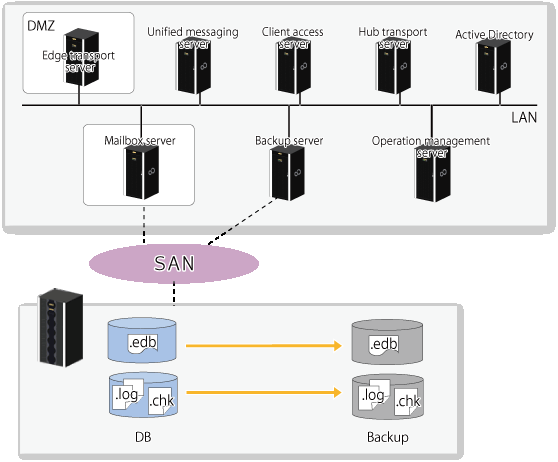
Non-DAG (Minimum Configuration)
Environment built with the client access server and hub transport server as the same server in an environment that does not have DAG configuration.
Figure 8.62 Non-DAG Configuration (Minimum Configuration)
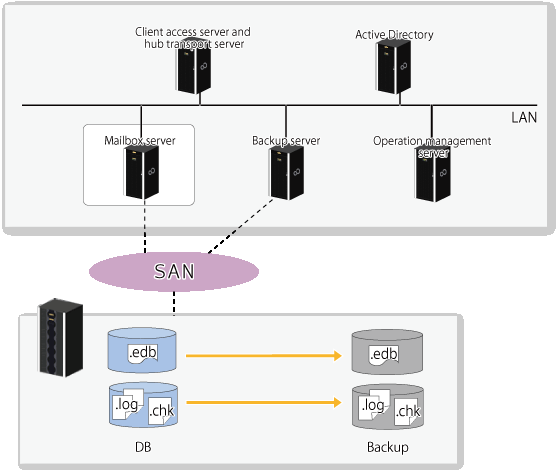
Overview of Server Roles and Functions
Please refer to the following for an explanation of the server roles pertaining to Exchange Server backup restore operation.
Server Type | Server Roles | Required/Optional | Co-existence with Other Servers |
|---|---|---|---|
Mailbox Server | This is the server that hosts the mailbox and public folder. This is the backup target server. AdvancedCopy Manager's agent, Storage Cruiser's agent, and. ETERNUS VSS Hardware Provider must be installed. | Required | Co-existence with the following servers is possible Client access server Hub transport server Unified messaging server *Cannot co-exist with the backup server and Management Server |
Client access server | This server hosts client protocols such as POP3, IMAP4, HTTPS, Outlook Anywhere, free/busy status service, and automatic detection services, among others. | Required | Co-existence with the following servers is possible Mailbox Server Client access server Hub transport server Unified messaging server Management Server |
Hub transport server | This is a mail routing server that routes mail in the Exchange Server system. *Automatically built as a monitoring server when DAG is created by default (mirroring monitoring server). | Required | Co-existence with the following servers is possible Mailbox Server Unified messaging server Management Server |
Edge transport server | This is the mail routing server that routes mail with the Exchange Server system and is set up on the perimeter network (DMZ). | Optional | Not possible (must be operated with DMZ so cannot co-exist with other roles operating in the LAN) |
Unified messaging server | This server connects the private branch exchange (PBX) system to the Exchange Server. | Optional | Co-existence with the following servers is possible Mailbox Server Client access server Hub transport server Unified messaging server Management Server |
Backup server | This is a dedicated backup server for online backup of the Exchange Server. A backup volume must be connected. AdvancedCopy Manager's agent, Storage Cruiser's agent, ETERNUS VSS Hardware Provider, and Exchange Management Tools must be installed. | Required | Not possible |
Management Server | This is a dedicated Management Server for online backup of the Exchange Server. It is necessary to Install ETERNUS SF Manager (AdvancedCopy Manager). | Required | Co-existence with the following servers is possible Client access server Hub transport server Unified messaging server *Cannot co-exist with Mailbox Server and backup server |
Note
Co-existence of the ETERNUS SF Manager (AdvancedCopy Manager's manager) and AdvancedCopy Manager's agent on the same physical machine is not supported.
Virtualization of all servers is supported, with the exception of Active Directory (see Note).
The virtualization environment's support range is based on the support range of the AdvancedCopy Manager and the support range of the VSSHP. For details, please refer to Table 8.6 For Virtual Environment Table.
Note: Active Directory virtualization is not recommended and is therefore not supported by this function.
Platform | Agent | Manager | |
|---|---|---|---|
VMware | Host | X | X |
Guest (*1) | O | O | |
Hyper-V | Host | O | O |
Guest | X | O (*2) | |
KVM | Host | - | O |
Guest | - | O | |
O: Supported
X: Not supported
-: Not for Backup Wizard for Exchange Server and Restore Wizard for Exchange Server
*1: VMware Tools must be installed.
*2: The Manager supports Windows Server 2008 R2, Windows Server 2012 and Windows Server 2012 R2.
The copying of the active mailbox databases shown below is also supported in those configurations which are located on each Mailbox Server.
Figure 8.63 Mixed Active Mailbox Databases and Passive Mailbox Databases (DAG Configuration)
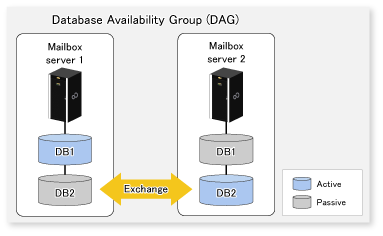
Using the Backup Wizard for Exchange Server and the Restore Wizard for Exchange Server, volume configurations which satisfy all of the following conditions are supported:
The volumes connected to the Mailbox server and the volumes connected to the backup server are the same size. (even bytes as a unit should be the same)
Volumes are configured in one partition for each LUN.
The mailbox database (.edb) and public folder database (.edb) are located in separate volumes.
The mailbox database, public folder database, and volumes where each transaction log and checkpoint are located have not been used for another purpose.
A drive letter or folder is allocated to the mount point of LUN.
LUN can be mounted to a drive letter or Windows empty NTFS folder.
To one volume to which databases are allocated, other databases are not allocated.
To one volume to which transaction log and checkpoint file are allocated, other transaction log and checkpoint file are not allocated.
Backup source volume and backup destination volume exist in the same ETERNUS Disk storage system.
The format (NTFS) of the file system of the volumes on the backup source and the backup destination are matching.
Figure 8.64 Supported Volume Configurations

Note
If the following conditions are not met, the volumes are not displayed in the Select list on the "Backup source / destination volume mapping" screen in the backup wizard:
The volumes connected to the Mailbox server and the volumes connected to the backup server are the same size. (even bytes as a unit should be the same)
For the volumes that are connected to the backup server, a drive letter or folder is allocated to the mount point of LUN.
Backup source volume and backup destination volume exist in the same ETERNUS Disk storage system.
In the case of a volume configuration that satisfies the following conditions, since the most up-to-date log file is lost by restore, roll-forward restoration cannot be performed. Only point-in-time restoration is possible:
The mailbox database, and transaction log and checkpoint of the mailbox database, are located in the same volumes.
The public folder database, and transaction log and checkpoint of the public folder database, are located in the same volumes.
In an environment where the version of AdvancedCopy Manager's agent in the mailbox server or backup server is 15.2, the volume configuration that satisfies the following conditions is not supported:
The mailbox database, and transaction log and checkpoint of the mailbox database, are located in the same volumes.
The public folder database, and transaction log and checkpoint of the public folder database, are located in the same volumes.
Any database whose database name contains the following characters cannot be backed up:
* ? : < > | &
It is recommended not to use the following characters for the database name of a database to be backed up. If the following characters are used, they should be escaped for Backup Execution Script created by the Backup Wizard:
. % @ ` ~ ' ! ( ) ^ - $ [ ] { } + #
Point
The only type of snapshot replication supported by this feature is the QuickOPC Type Replication.